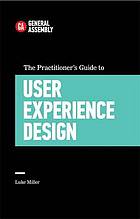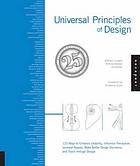understanding the user's task

Read these to prepare for class discussion
-
Chapter 2, Creativity Loves Constraints,
pages 44-63
in Miller, L. (2015). The practitioner's guide to user experience design.
New York; Boston: Grand Central Publishing. -
Universal principles of design
Hierarchy of needs, 124 -
a relevant article from the Nielsen Norman Group
Incompetent Research Skills Curb Users' Problem Solving -
Uden, L., Valderas, P., & Pastor, O. (2008).
An activity-theory-based model to analyse Web application requirements.
Information Research, 13(2), paper 340.
Read only the following sections:
⇒ Activity theory background
⇒ Activities, actions and operations
⇒ Applying activity theory to the analysis of Web application requirements
⇒ Benefits of activity theory for Web requirements

[top]
Optional readings which may come up in class discussions
Johnson, J., & Henderson, A. (January 01, 2002).
Design: Conceptual Models: Begin By Designing What to Design.
Interactions, 9, 1, 25-33
[PDF]
ON METAPHORS
Hudson, W. (2000).
Metaphor: a double-edged sword.
interactions, 7(3): 11-15.
[PDF]
ON COGNITIVE TASK ANALYSIS
Vicente, K. J. (1999).
Cognitive Work Analysis: Toward Safe, Productive, and Healthy Computer-Based Work.
Mahwah, NJ: Lawrence Erlbaum.
[QA76.9.H85 V515 1999]
or as [e-book]
⇒ Chapter 4, Descriptive approaches to work analysis: "What workers really do", p87-108
Wei, J., & Salvendy, G. (2004).
The cognitive task analysis methods for job and task design:
Behaviour & Information Technology, 23(4), 273-299.
[PDF]
ON ACTIVITY THEORY
Wilson, T.D. (2006). A re-examination of information seeking behaviour in the context of activity theory. Information Research, 11(4), paper 260.
Constantine, L.L. (2006).
Activity modeling: Toward a pragmatic integration of activity theory with usage-centered design.
Chap. 3, pp. 27-53 in
Seffah, A., Vanderdonckt, J., & Desmarais, M. C. (2009).
Human-centered software engineering: Software engineering models, patterns and architectures for HCI.
London: Springer.
[e-book]
Kaptelinin, V. (1996).
Activity theory: implications for human-computer interaction.
In Nardi, B. A. (ed.),
Context and Consciousness: Activity Theory and Human-Computer Interaction.
Cambridge, MA: MIT Press, 103-116.
[QA76.9.H85 C68 1996]
Kuutti, K. (1996).
Activity theory as a potential framework for human-computer interaction research.
In Nardi, B. A. (ed.),
Context and Consciousness: Activity Theory and Human-Computer Interaction.
Cambridge, MA: MIT Press, 17-44.
[QA76.9.H85 C68 1996]
ON GOMS
John, B. E., & Kieras, D. E. (1996).
Using GOMS for user interface design and evaluation: which technique?
ACM Transactions on Computer-Human Interaction, 3(4), 287-319.
[PDF]
John, B. E., & Kieras, D. E. (1996).
The GOMS family of user interface analysis techniques: comparison and contrast.
ACM Transactions on Computer-Human Interaction, 3(4), 320-351.
[PDF]
Useful, but not available online
Bertelsen, O. W., & Bødker, S. (2003).
Activity theory.
In Carroll, J. M. (ed.),
HCI Models, Theories, and Frameworks: Toward a Multidisciplinary Science.
Amsterdam: Morgan Kaufmann, 291-324.
[QA76.9 .H85 C367 2003]
Bødker, S. (1991).
Through the Interface: A Human Activity Approach to User Interface Design.
Hillsdale, NJ: Lawrence Erlbaum.
[QA76.9.H85 B63 1991]
⇒ Chapter 2, Human activity and human-computer interaction, p18-56.
John, B. E. (2003).
Information processing and skilled behavior.
In Carroll, J. M. (ed.),
HCI Models, Theories, and Frameworks: Toward a Multidisciplinary Science.
Amsterdam: Morgan Kaufmann, 55-101.
[QA76.9 .H85 C367 2003]
MacKenzie, I. S. (2003).
Motor behavior models for human-computer interaction.
In Carroll, J. M. (ed.),
HCI Models, Theories, and Frameworks: Toward a Multidisciplinary Science.
Amsterdam: Morgan Kaufmann, 27-54.
[QA76.9 .H85 C367 2003]
[top]

